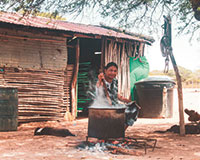Matter and gloom
An architecture in the desert
DOI:
https://doi.org/10.18861/ania.2021.11.1.3059Keywords:
Traditional architecture, cultural identity, rite, customs and traditions, Wayúu, Península La Guajira, ColombiaAbstract
This text addresses the study of the architectural devices that characterize the habitat of the Wayúu community located on Colombia's La Guajira peninsula, in order to relate the symbolic value of their habitat contained in their domestic spaces, associated with rituals and myths, to draw some elements and forms contained in their architectures and understand aspects of their value as carriers of meanings. An inventory was built describing and reflecting on each of these devices, their daily uses and rituals, formal configurations and mythical background, which make up a simple but efficient architecture, with technical parameters that deserve to be counted and protected by their rich cultural content; data that was collected through field studies and interviews. Understanding the worth of heritage not as a liability of nostalgia, but as an asset of memory.
Downloads
References
BARRERA, E. (2014). Guerras Hispano Wayuu del Siglo XVIII. Universitas Humanística, 29(29). Recuperado a partir de https://revistas.javeriana.edu.co/index.php/univhumanistica/article/view/9974
CASSIRER, E. (1947) El Mito del Estado. México: Fondo de cultura Económica.
DAZA-DAZA, ALCIDES R., SERNA-MENDOZA, C., & CARABALÍ-ANGOLA, A. (2018). El Recurso Agua en las Comunidades Indígenas Wayuu de La Guajira Colombiana. Parte 2: Estudio Cualitativo de las Condiciones de Higiene, Aseo y Disponibilidad de Agua. Información tecnológica, 29(6), 25-32. https://dx.doi.org/10.4067/S0718-07642018000600025
ECHAIDE, R.(1990) La cabaña primitiva en la arquitectura actual. Revista de Edificación RE 7(1).
FORERO, A. (1995). Nosotros los Wayuu. Bogotá: Universidad Francisco José de Caldas.
GARCÍA FANLO, L. (2011). ¿Qué es un dispositivo? Foucault, Deleuze, Agambem. A Parte Rei. Revista de Filosofía (74). http://serbal.pntic.mec.es/AParteRei/page84.html (Consultado el 24 de noviembre de 2020)
GUERRA, W. (1998). Introducción. En HARKER, S. Wayuu, Cultura del desierto colombiano, 5-7. Bogotá: Villegas editores.
LAUGIER, M. (1999). Ensayo sobre arquitectura. Paris: Akal Ediciones, S.A.
LIZARRALDE, R. Y PERRIN, M. (1971). Prólogo al disco Chicha Mayo, Folclor de la Guajira Venezolana. Caracas: Sello Laffer.
LÓPEZ, J. (1786). Carta plana de la provincia de La Hacha; situada entre las de Santa Marta y Maracaybo. Obtenido desde: https://bvpb.mcu.es/en/consulta/registro.do?id=422892 (consultado el 24 de noviembre de 2020)
MARÍN, E. (2014). Cosmogonía y rito en la vivienda Wayuu. Tesis de Maestría. Manizales: Universidad Nacional de Colombia.
NIÑO MURCIA, C. (2019). Territorio chamánico. Bogotá: Instituto Colombiano de Antropología e Historia.
PAZ IPUANA, R. (1972). Mitos, leyendas y cuentos Guajiros. Caracas: Instituto Agrario Nacional. Caracas Venezuela.
RAMIREZ ZAPATA, M., POCATERRA, J. (1995). Wale Keru, Tomo I. Bogotá: Artesanías de Colombia.
SALDARRIAGA ROA, A. (2017). La arquitectura en Colombia en varios tiempos. Revista Credencial Historia (334). Consultado el 19 de noviembre de 2020. http://www.revistacredencial.com/credencial/historia/temas/la-arquitectura-en-colombia-en-varios-tiempos
SEMPER, G. (1851). Los Cuatro Elementos de la Arquitectura, Trans. Harry F. Mallgrave and Wolfgang Herrmann. Cambridge, 1989.
URIBE TOBÓN, C., VÁSQUEZ CARDOZO, S., CORREA CORREA, H., JARAMILLO GÓMEZ, O. (2001). Geografía Humana de Colombia Nordeste Indígena, Tomo II. Santafé de Bogotá: Instituto Colombiano de Cultura Hispánica.
VILLALOBOS, S., VARGAS, O Y MELO, S. (2007). Uso, Manejo y Conservación de “yosú”, Stenocereus griseus (cactaceae), en la alta Guajira colombiana”. Acta Biológica Colombiana 12 (1): 99-112.

Published
Versions
- 2021-05-06 (3)
- 2021-04-27 (2)
- 2021-02-11 (1)
How to Cite
Issue
Section
License
Copyright (c) 2021 Ana Mercedes Suárez Velásquez, Álvaro Hernán Acosta Páez, Owen David Gonzalez Obando, José Luis Suárez Montiel, Maria Angélica Orozco Rodríguez

This work is licensed under a Creative Commons Attribution 4.0 International License.
The journal and its contents are licensed under the Creative Commons - Attribution 4.0 International License (CC BY 4.0). It is possible to copy, communicate and publicly distribute its content as long as the individual authors and the name of this publication are cited, as well as the publishing institution (Universidad ORT Uruguay).

